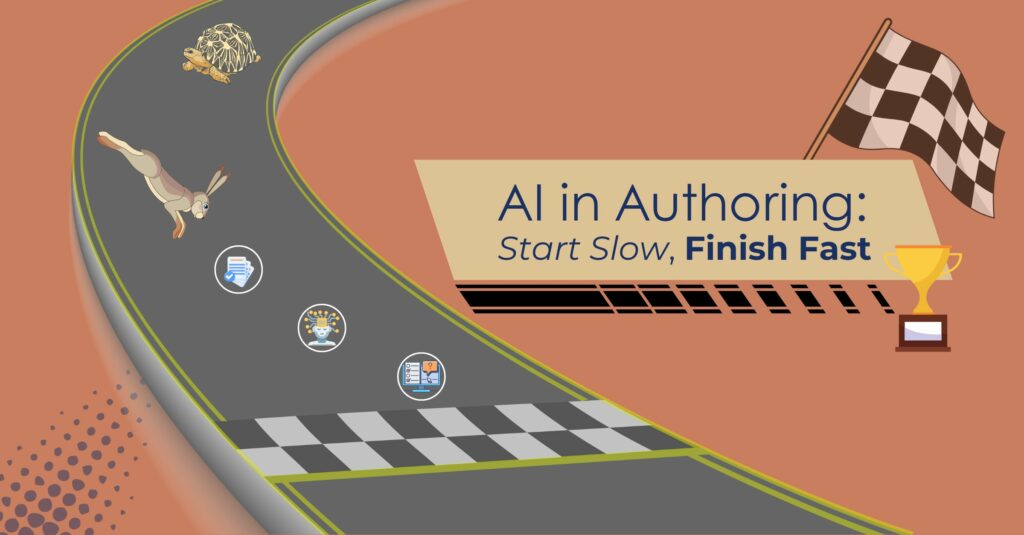
AI-enabled tools can help optimize authoring processes and lead to significant value capture. But, hastily implementing these solutions – or worse, choosing the wrong solution – can cause more trouble than it’s worth. In this post, we’ll break down why pharmaceutical companies should “start slow to go fast” and what this method means for your business.
Traditional content authoring is time-intensive, manual, and prone to human error – it is no wonder that AI-enabled tools are increasingly viewed as the “silver bullet” that will help global pharmaceutical companies speed up the process. But, when it comes to choosing an AI solution for your specific use case, there’s no need to rush. Pharmaceutical companies should take time to analyze their business processes and select the right tool so their automation efforts succeed the first time. Let’s discuss what this means and how to implement this process for your use case.
Content Authoring: The Case for Intelligent Automation
It is no secret – content authoring is a manual, time-consuming process that often draws the ire of global pharmaceutical companies looking to be first to market with novel medicines. It typically takes more than twelve months to generate, approve, and distribute drug labels, and each time an update is required, hundreds of people – ranging from regulatory affairs professionals to scientific writers, to labeling teams – need to work together, copying and pasting into a single document.
Although regulations help ensure the quality and consistency of the authoring process, with so many individuals writing, reading, and translating a single document, human error, and delays are bound to occur. And in an environment where patient safety is paramount, time is of the essence and there is no margin for error.
Fortunately, the emergence of technologies such as machine learning and artificial intelligence have made it possible to automate several aspects of the content authoring process. A recent study found that combining existing structured authoring and component management systems with innovative, industry-specific AI- and ML-enabled tools can help reduce the time it currently takes pharmaceutical companies to develop and revise product labels by up 50%, significantly impacting patient safety and outcomes.
Further, industry-tailored and AI-enabled tools can mitigate the risk of manual errors, increase productivity by decreasing delays between steps, and help the team better understand how and why a label was rendered over time. With quality, productivity, compliance, and patient safety top of mind, it makes perfect sense that pharmaceutical companies are rushing to incorporate these technologies into their processes. But will AI-enabled tools really prove to be the “silver bullet” that speeds up the content authoring? The short answer is yes, but only if the right tools are selected and properly implemented. The right tools will provide various benefits, such as:
- Increased Productivity. Automated data mapping, for example, can reduce manual and non-value add efforts across labeling and regulatory teams and elevate overall team capabilities by driving a higher level of skill and efficiency in performing work. No more copy, pasting and re-creating tables, lists, and graphs.
- Improved Quality. Change management and change bundling capabilities native to many AI-enabled tools allow labels to be updated at the source, eliminating the human error associated with making updates across multiple documents.
- Sustained Compliance. Audit trail functionality allows internal compliance, health authorities and other regulators to understand how and why a label was rendered over time; Patient safety improves because of faster publication of clinical research outputs.
- Lower Costs. Improved productivity and process quality reduce employee overtime due to rework and delays, as well as the third-party costs meeting global requirements (translation, etc.).
Start Slow
So, how do you ensure content authoring automation efforts succeed the first time? Start slow. As the adage goes, “if you start running before you determine where the finish line is, you’ll likely be running in the wrong direction, and the faster you go, the farther behind you’ll be.” With new, exciting technologies like artificial intelligence and machine learning, it is tempting for pharmaceutical companies to jump in with abandon – especially when improvements around quality and patient safety are at stake. But if proper research and planning are forsaken for speed, already-slow content authoring processes can become even slower. It may sound counter-intuitive to slow down in a situation where patient safety is potentially impacted, but slowing down gives you the opportunity to ask questions and make sure you’re “running in the right direction.”
Broadly speaking, stepping back to understand the current content authoring processes and business needs, design the desired future state, and formulate a plan to get there may not only help pharmaceutical companies avoid the pitfalls of selecting the wrong tool, but also ensure that the implementation of authoring automation succeeds the first time.
The Downside of Speed
There are many potential consequences to moving too quickly:
#1 – Failure to select the right tool might do nothing at all to speed up the content authoring process, or it may result in expanded workflows that have been made excessively complicated. Not only can this increase variable costs and decrease employee productivity and morale, but it can also cause longer lead times for communicating vital drug updates to doctors and patients.
#2 – Selecting the wrong tool can result in a need for extensive re-deployments or costly future upgrades to match business requirements. It is possible the solution may even need to be discarded all together, leading to significant replacement costs. Similarly, inadequately planning for or executing the implementation can keep the automation efforts from succeeding. Insufficient planning exposes the project to unpredicted high risks and problems, which can be costly. Lack of support from key stakeholders can similarly lead to adoption failure, as the required time and resources may not be set aside for the project.
#3 – Not conducting a detailed process review can mean that bad processes are automated, further entrenching these processes.
While it is critical to start slow, it is also important to avoid analysis paralysis. The applications of artificial intelligence are diverse and innovative technology players are scaling up fast – it can be difficult to determine where and how AI can add the most value along the content authoring lifecycle.
At Glemser, we have partnered with organizations across the industry to do just that. Through conducting a methodical review of various content authoring business practices, we have developed complex end-to-end labeling scenarios that allow our partners to take the guesswork out of understanding what their new, automation-powered authoring workflows could look like. With partner feedback in mind, we have built ComplianceAuthor AI, a comprehensive solution for managing label components, as well as global and locally assembled labeling documents incorporating component-based authoring, artificial intelligence, and machine learning. Pharmaceutical companies that choose ComplianceAuthor AI can rest easy knowing they have a proven end-to-end solution to speed up their authoring process.
Moving From Slow to Fast
Tactically speaking, how do you go from moving slowly to going fast? You have set yourself up for success by meticulously reviewing your processes, selecting an industry-tailored and AI-enabled tool that can meet your business needs, and developing a detailed implementation plan – what now? The next step, the one that really catapults you from slow to fast, is to put the AI-enabled tool into practice.
Deploying intelligent, purpose-built automation not only creates greater consistency and productivity within teams, but it also reduces the chances of mistakes and information gaps. And, if you go slow to go fast during implementation, you can greatly reduce the opportunities for any errors, human or otherwise.
The Benefits of ComplianceAuthor AI
For pharmaceutical companies seeking to speed up their content authoring process(es) without messing with the foundations of it, ComplianceAuthor AI’s unique combination of natural language AI models, structured content authoring software with integrated health authority outputs, and human experts provides a powerful, trend-riding solution. ComplianceAuthor AI not only supports an ecosystem of health authorities and local operation business interactions for improved time to market, but it also helps pharmaceutical companies achieve regulatory compliance.
Formatting Specifically for Life Sciences
Current systems cannot transform a Core Data Sheet (CCDS) to a local label format (USPI, QRD, etc.). Getting the information from the Core Data Sheet into the right format can take hours, and the quality of submissions is at risk from manual errors.
ComplianceAuthor AI uses an inside-out approach to easily scale and generate any required document type or output. ComplianceAuthor AI’s natural language processing and generation models have been trained on life sciences data to help automate the most time-intensive steps in the authoring workflow – from cutting and pasting to rewriting to XML conversion – and the system’s proven core harmonizes agency-neutral content with meta-data, attributes, and properties for creating modular components and data-driven documents at the section level. Once the components are created, the system’s out-of-the-box, drag-and-drop functionality reduces label format generation from hours to minutes, and mapping can be automated for an even faster process.
ComplianceAuthor AI is also capable of interfacing with artwork management systems (LIFT AMS, InDesign), eliminating the need for a graphic designer or label author to spend non-value-added time manually moving graphics, illustrations, or images into a label.
Generative AI Capabilities
ComplianceAuthor AI’s generative AI capabilities can also help pharmaceutical companies speed up their content authoring processes by providing automated recommended translations for review and approval. Language differs across cultures and geographies, and warnings can appear differently depending on where the local label is distributed. ComplianceAuthor AI applies generative AI to write rich, compelling narratives based on insights from existing datasets. It also has the capability to generate guidelines for improvement and standardization which improve the quality and consistency of patient safety narratives across geographies where a particular pharmaceutical product is distributed.
Sustained Compliance
Additionally, as labeling teams generate, review, and approve content on the front end, ComplianceAuthor AI continuously maintains everything in its appropriate health authority output format on the back end – all without coding or manual conversion. ComplianceAuthor AI ensures perpetually sustained compliance via Natural Language Processing CFR Part 11 and is EU Annex 11 compliant with e-signature capabilities out-of-the-box.
Labeling teams can also Review real-time status and timelines via dashboards and reports for proactive management to adhere to regulatory and internal timelines, and audit trail and label versions are available to help all stakeholders better understand how and why a label was rendered over time, shortening lengthy review and approval processes.
User-Friendly
Finally, and perhaps most importantly, ComplianceAuthor AI is also easy to use. The tool leverages a Microsoft Word Plugin, XML Author, to drive the “locked down”, simplified authoring experience in the same interface. This plug-in provides all the control and structure of XML while the user interface is the familiar MS Word interface.
This allows for simple and quick end-user adoption, minimal training, and enhanced benefits of structured content, allowing pharmaceutical companies to start going fast from day one of deployment.
Final Thoughts
At the end of the day, “starting slow to go fast” is the best way to implement a new content authoring tool into your current process. Utilizing this method will ensure that you choose the right solution the first time around and experience the value you need.
Wondering how you can speed up the content authoring process at your pharmaceutical company? Contact Glemser today to get started.


